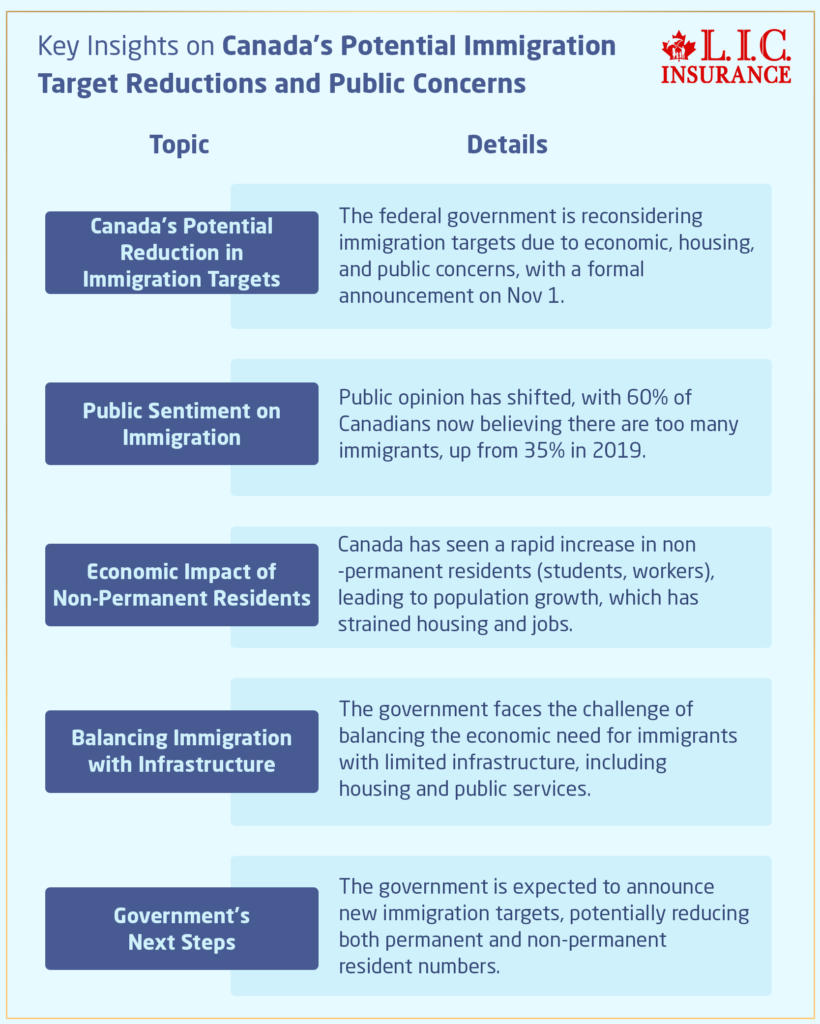- Connect with our licensed Canadian insurance advisors
- Shedule a Call
Basics
- What Is the New Immigration Policy in Canada in 2024?
- Impact of Changing Mortgage Rates in Canada: How to Protect Your Investment with the Right Mortgage Insurance
- Smart Financial Moves for Women in Their 50s
- How Will the New Measures Announced in 2024’s Budget Impact You?
- Is Life Insurance a Good Investment in Canada?
- What is the Average Life Expectancy in Canada?
- How Much Does a Funeral Cost in Canada 2023?
Reviews
Common Inquiries
- How Can One Appeal a Denied Claim Under Super Visa Insurance?
- Can a Visitor Visa Be Converted to a Super Visa?
- Can I Include My Spouse in the Same Super Visa Insurance Policy?
- How Do I File a Complaint About My Super Visa Insurance Provider?
- How to Find the Most Affordable Super Visa Insurance Plan?
- Is a Medical Test Required for Super Visa Canada?
- Can I Pay Monthly for Super Visa Insurance?
Canada Reduce Its Immigration Targets? Analysts Speculate on Changes to Immigration Levels as November 1 Announcement Approaches
SUMMARY
As Canada debates reducing immigration targets, this blog examines public concerns over housing, jobs, and infrastructure. Analysts speculate on potential changes as the federal government prepares to announce its updated immigration levels on November 1. Canadian LIC highlights the economic impact of non-permanent residents, the strain on infrastructure, and the need to balance immigration with available resources to support families and businesses.
- 11 min read
- September 25th, 2024

By Harpreet Puri
CEO & Founder
- 11 min read
- September 25th, 2024
Introduction
Ottawa, September 2024—With public interest overarching in the past ten years due to their direct effects on the economy, housing market, and jobs, the case of immigration into Canada has been a very contentious public debate. Of late, the tone of the public narrative appears to be shifting, foretelling a possible re-examination of the country’s Immigration targets by the federal government. Ahead of the new wave of Immigration statistics that will be released on November 1, so many are now debating this very question: Will Canada reduce its immigration targets?
Immigration Minister Marc Miller has been part of those discussions, and what once was a hardened approach to preserving high immigration numbers is softening. Last year, he explained unequivocally: “I don’t see why we should necessarily reduce levels at this point in time.”. But today, his tone is more cautious, reflecting a bigger sense that perhaps Canada’s pace of bringing in new residents, especially non-permanent ones, may need to slow down.
The Current Reality: Canada's Overheated Immigration System
Immigration has been a goldmine for the Canadian economy and has greatly contributed to the flow of the food services, transportation, warehousing, and professional sectors. However, on the other hand, most Canadians bear the weight of this growing population. Housing prices sit at an all-time high, and competition for jobs, especially for young and immigrant folks, has become stiff. For most, it feels like there is no space left in the system.
This attitude has caused a shift in opinion. According to the last poll by Leger Marketing Inc., 60 percent of Canadian participants stated that they think that there are too many immigrants in this country. It is noteworthy that back in 2019, just 35 percent of those polled shared this opinion. The change in public attitude is not in isolation, and many experts believe that this increasing concern would nudge the government to recalculate its set immigration targets.
At Canadian LIC, we understand the very real struggles that many Canadians are experiencing due to these rapid changes. In our day-to-day dealings with clients, we’ve heard countless stories of families facing difficulties in securing affordable housing, finding jobs, and navigating an increasingly competitive economy. While immigration is essential to our country’s growth, these challenges are becoming too significant to ignore.
Minister Miller's Evolving Stance on Immigration
A year ago, Immigration Minister Miller was blunt and reassuringly forceful in his message that immigration targets would remain high. In August 2023, just weeks after taking over the immigration portfolio from Sean Fraser, he declared, “Looking at the numbers and knowing what I know and the needs that exist in Canada, I don’t see a world in which we decrease it currently.”
However, as we approach the November 1 announcement, Miller’s responses have been more guarded. In a recent press conference, he stated, “I am considering a lot of things … we are putting together a number of propositions … and those choices will be ones that we will have to decide in cabinet, but you will know on November 1.” Prime Minister Justin Trudeau has echoed these sentiments, noting that immigration numbers are a subject of “ongoing conversations” within the government.
This change in vocabulary may indicate that the central government is having a rethink on the policies it adopted earlier on immigration. The debates are binary. While the hotel and tourism industry, among others, is manifestly deficient in the labour force, corporations require labour if they are to hit their targets, but the infrastructure, most notably housing, cannot keep pace with the expanding population.
Situations at Canadian LIC indicate this occurrence firsthand. Our clients, whether new immigrants or long-time residents, are dealing with the reality that the country’s resources are being stretched thin. Families are asking tough questions: “Will I be able to afford a home?” “Can my children find stable jobs in the current market?” These are concerns we hear daily, and we strive to provide financial solutions and insurance products that can help them find some stability in uncertain times.
Non-Permanent Residents: A Key Factor in the Debate

The growth in non-permanent residents – comprising international students, foreign temporary workers, and asylum seekers – has been one of the strong growth drivers of Canada’s population over the last couple of years. In mid-2024, about 2.8 million people resided in Canada as non-permanent residents – a staggering increase from the 1.3 million people in 2022. Much of that is attributed to filling up those job vacancies during the pandemic.
Although this influx of temporary residents has certainly raised Canada’s economic output and avoided recession, it also entailed some unjustified consequences. Indeed, according to Minister Miller, who spoke at a news conference in September, the government let some immigration programs “overheat” for too long. Now, with decreasing job openings and increasing rates of unemployment among youth and immigrants, the federal authority has reduced the numbers.
Cutting five percent of the total population into non-permanent residents by 2026 from 6.5 percent at present. This move marks a far wider recognition of the fact that, while immigration is the key to economic growth, there needs to be balance, and people must be brought in, plus infrastructure must be made to welcome them.
At Canadian LIC, we help both new immigrants and established residents. The ills of immigration, housing, and employment are big enough challenges in themselves, which is why we strive hard for insurance solutions that settle the peace of mind and security of such uncertain times.
The Role of Permanent Residents in Canada's Future
Permanent immigration remains a key driver of the Canadian economic growth plan. In 2022, the federal government established a target for 500,000 permanent residents by 2025. It was an ambitious goal, but most observers of the Canadian scene felt that the goal would have to be met due to population aging and overall workforce shortages.
However, a very astute analysis from a Bank of Nova Scotia analyst such as Rebekah Young did say that there’s now a growing consensus that the nation may have gone too far in swelling population growth at this speed. There’s now the issue of housing, and it has to bleed into infrastructure, healthcare and educational systems, which have become overburdened.
Some analysts predict the government will lower permanent residents targets, while others, like CIBC’s Benjamin Tal, said: “I think they will leave it at about 500,000 because the economy needs this number. But even if they do decrease, it won’t be a significant number.”.
Businesses that are reliant on economic immigrants, such as hospitality and tourism operations, may be affected if the immigration targets are to be reduced. However, it has already been acknowledged that the current population growth cannot be supported. The coming months would call for a harmonious balance between the economic needs of Australia and the country’s capability to accept its new residents.
At Canadian LIC, we believe in helping families and individuals secure their future in Canada, regardless of the changes to immigration policies. We know that planning for the future is more important than ever, especially in times of uncertainty. That’s why we offer a range of insurance products that can provide the financial security and support needed to navigate the changing landscape.
The Path Forward: What to Expect on November 1
As we get to the November 1 announcement, all eyes will be on the federal government’s Immigration Levels Plan. The plan will not only report on how many permanent residents Canada plans to admit over the next three years but, for the first time, will establish targets for non-permanent residents. It is one of those changes that analysts believe will initiate a new chapter in Canada’s immigration policy.
Speculation exists that the federal government may scale down on its target for immigration. For example, as public pressure mounts and more pressure is exerted on existing infrastructure, it is said that some experts think that the federal government has no alternative but to scale down its targets as they are currently set. Others believe any scaling down will be marginal because Canada still needs immigrants to fill its economy.
Whatever the future holds, we can surely predict this: the immigration debate has far from reached its end. As Canada fights its growing population and blends economic growth with infrastructure development, we here at Canadian LIC continue to be dedicated to helping our clients prepare for their futures.
We provide a wide variety of insurance products aimed at stabilizing and securing the lives of individuals who navigate the complexities of immigration, housing, and employment. Whether you are a new immigrant or a long-time resident, we understand the challenges you face, and we are here to help you every step of the way.
So, keep an eye out for that November 1 announcement and have faith that Canadian LIC will continue to provide the insurance solutions you’ll need to thrive in Canada, no matter what the future may bring.

More to Learn
- What Is the New Immigration Policy in Canada in 2024?
- Impact of Changing Mortgage Rates in Canada: How to Protect Your Investment with the Right Mortgage Insurance
- What Happens If My Life Insurance Provider Goes Bankrupt?
- How Can You Use Whole Life Insurance to Create Wealth?
- What Is the Uptake of RESPs Among Different Communities in Canada?
- 5 Steps to Ensure Your Life Insurance Application is Approved
- How Does Inflation Affect My Critical Illness Insurance Coverage?
- Can Family Members Visiting Together Get a Group Discount on Visitor Insurance?
- Smart Financial Moves for Women in Their 50s
- How Will the New Measures Announced in 2024’s Budget Impact You?
- What is the Average Life Expectancy in Canada?

FAQs: Canada's Immigration Targets and Impact on the Economy
Canada reassesses immigration targets amid rising concern over the country’s population growth sustainability. Public sentiment has shifted, with many Canadians worried about housing shortages, rising unemployment, and the strain on infrastructure. In addition, the rise in the number of non-permanent residents, such as international students and temporary employees or foreign workers, has led the government to believe that growth in the economy must be strengthened along with saving resources.
Permanent residents are persons who have been accorded the right to stay and work in Canada without limitation as to time. One is also allowed to apply for Canadian citizenship at one’s discretion. International students, temporary foreign workers, and asylum seekers fall under the non-permanent residents. These individuals enter Canada for a limited term for which they have acquired work or study permits. It was not long ago that the rate of growth of non-permanent residents propelled the growth rate of Canada’s population.
The major issues are the scarcity of cheap accommodations, the overwhelmed infrastructure of health and education, and a growing unemployment rate, above all youth and immigrant populations. Population growth happened very fast, and this placed quite an overwhelming load on the demand for basic services and infrastructure within the country. These are some of the leading issues driving the debate regarding the reduction of immigration targets.
The target set up by Canada in 2022 is the admission of 500,000 permanent residents to the country before the year 2025. This number was apparently to be submitted to fill the shortages in the workforce and also to counter the aging population in the country. Most analysts believe that the November 1 announcement will possibly change the targets of these admissions according to the kind of public pressure that is being brought forward with definite infrastructure limitations
There is some debate on this. While some analysts argue that reducing immigration could slow down sectors that depend on new workers, like tourism and hospitality, others believe that Canada’s infrastructure is already too strained to handle more residents. Businesses facing labour shortages could feel the impact of economic immigration is reduced, but the overall balance between economic growth and resource capacity is a critical consideration for the government.
The increases in international students, temporary foreign workers, and asylum seekers as categories of non-permanent residents have taken the population of Canada to great heights. By mid-2024, the number of non-permanent residents had risen to 2.8 million from 1.3 million recorded in 2022. Although they managed to fill most of the job openings, the increasing numbers brought about housing shortages and competition for jobs, leading the government to place limits on further entry.
The government has implemented a series of measures over the last year to cut the number of non-permanent residents. In fact, it decreased the quota of international study permits for 2025, capped international students for two years and curbed the eligibility of graduates and their spouses to apply for work permits. It is aiming at bringing down the number of non-permanent residents to five percent of the population by 2026.
Canada has a growing elderly population and hence needs a younger working population to support its economic performance. Immigrants, therefore, have a significant role in filling gaps in the labour market, mainly within the health services sector, food services sector, and other sectors such as transportation. Hence, it is this aspect that the government immigration targets were weighed and pegged as a means to ensure that Canada could support its economic growth despite the rising population of old people in the country. This, however, now faces pressure to balance with the country’s capacity to absorb new residents.
On November 1, the Canadian government will announce its updated Immigration Levels Plan. This plan will set the targets for the number of permanent residents the country plans to admit over the next three years. For the first time, the plan will also include targets for non-permanent residents, marking a significant shift in how immigration is managed.
Canadian LICs come to the rescue of both newcomers and long-time residents by guiding them through changes in immigration policies and the associated challenges of a growing population. We provide a range of insurance products for housing, employment, and future planning.
We understand the struggles many families and individuals are going through, and we can help you determine the best solutions in order to protect your financial well-being during these uncertain times.
Sources and Further Reading
- Government of Canada – Immigration Levels Plan
- Official announcements and immigration statistics from the Canadian government regarding permanent and non-permanent residents.
- Statistics Canada – Population Estimates
- Detailed population growth figures, including data on non-permanent residents and their impact on the economy.
- https://www.statcan.gc.ca/en/subjects-start/population_and_demography
- Leger Marketing Inc. – Public Opinion Poll on Immigration
- Recent poll results showing the shift in Canadian public opinion on immigration targets.
- https://leger360.com
- Bank of Canada – Economic Impact of Population Growth
- Analysis of the economic consequences of rapid immigration and population growth.
- https://www.bankofcanada.ca
- Canadian Chamber of Commerce – Immigration and Business Needs
- Insights into how immigration affects the Canadian labor market and business sectors, including the challenges faced by industries like hospitality and tourism.
- https://chamber.ca
- CIBC World Markets Inc. – Economic Commentary on Immigration
- Expert analysis from leading economists on the implications of adjusting immigration targets and the balance between economic growth and infrastructure capacity.
- https://www.cibc.com/en/personal-banking.html
- Bank of Nova Scotia – Population Growth and Economic Sustainability
- Reports and comments from economists on whether Canada’s immigration pace is sustainable in the long term.
- https://www.scotiabank.com/ca/en/personal.html
These sources provide a comprehensive understanding of Canada’s immigration policies, economic impact, and public sentiment leading to the potential adjustments in immigration targets.
These sources provide valuable information for international students looking to better understand Travel Insurance and the benefits of having proper medical coverage while studying in Canada.
Key Takeaways
- Potential Reduction in Immigration Targets: Canada may lower its immigration targets as public concerns grow about the impact on housing, job markets, and infrastructure.
- Shifting Public Opinion: A significant increase in the number of Canadians who feel there are too many immigrants is influencing government considerations.
- Economic and Infrastructure Strain: Rapid population growth, driven by non-permanent residents, has put pressure on housing and job availability, leading the government to reconsider its stance.
- Balanced Approach Needed: The federal government faces the challenge of balancing economic growth with the need to manage infrastructure capacity and public sentiment.
- Impact on Businesses: While businesses, particularly in sectors like tourism and hospitality, rely on immigration to address labor shortages, they may face difficulties if targets are reduced.
- November 1 Announcement: The Canadian government will reveal its updated Immigration Levels Plan, which may include revised targets for both permanent and non-permanent residents.
- Canadian LIC Support: During these uncertain times, Canadian LIC offers tailored insurance solutions to help families and individuals navigate the challenges posed by changing immigration policies.

By Pushpinder Puri
CEO & Founder
Your Feedback Is Very Important To Us
We appreciate your time and feedback on the potential changes to Canada’s immigration targets. Your responses will help us better understand the concerns and struggles Canadians may face.
Thank you for your time! Your feedback will help us improve our services and better meet the needs of Canadians and international students alike.
IN THIS ARTICLE
- Canada Reduce Its Immigration Targets? Analysts Speculate on Changes to Immigration Levels as November 1 Announcement Approaches
- The Current Reality: Canada's Overheated Immigration System
- Minister Miller's Evolving Stance on Immigration
- Non-Permanent Residents: A Key Factor in the Debate
- The Role of Permanent Residents in Canada's Future
- The Path Forward: What to Expect on November 1
